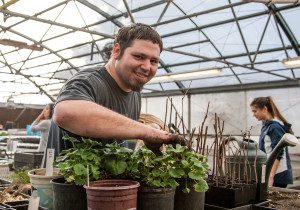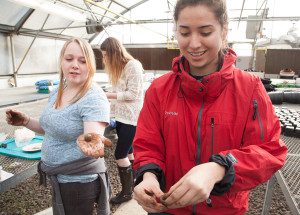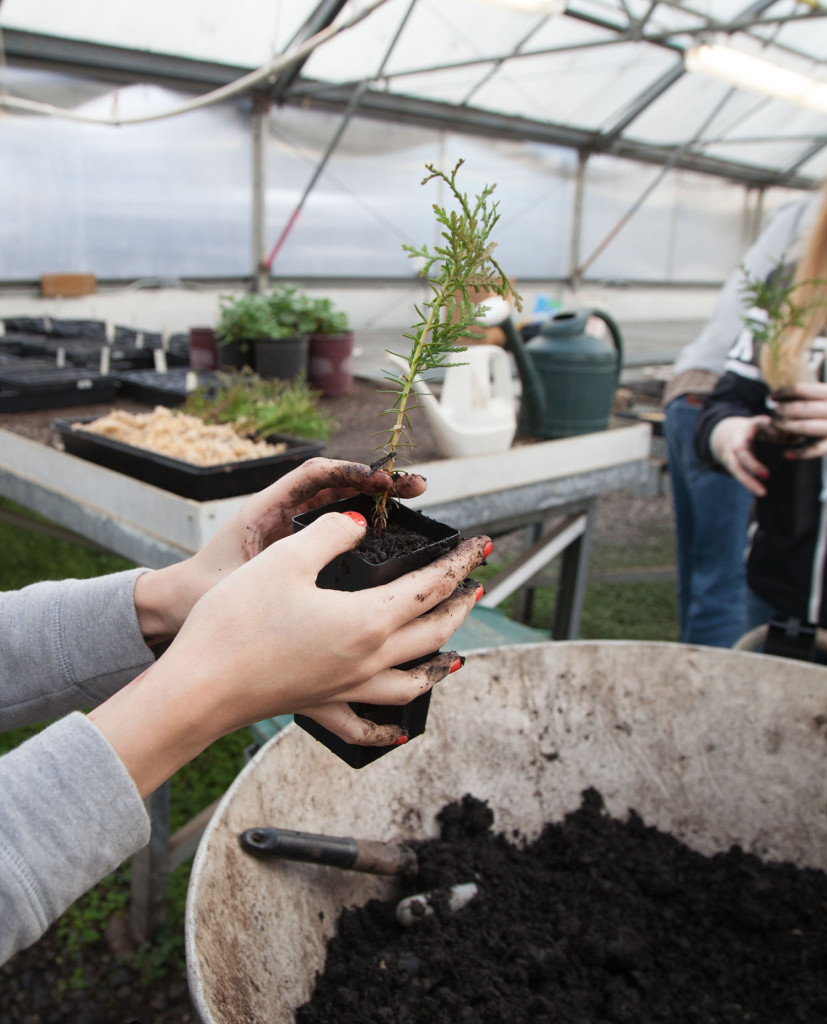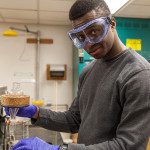A living, learning lab
Clark’s greenhouse teems with native plants, educates students on sustainability
By Toccara Stark
Students move among stations at Clark College’s greenhouse, preparing cuttings from snowberry bushes, forming showy milkweed seed balls and potting more than 2,000 donated cedar trees. Students hold up their soil-covered hands as they listen to instructions on what to do next.
“Matilda has great consistency to her seed balls. Come see hers!” calls out Erin Harwood, a biology and environmental science instructor, and the college’s science, technology, engineering and mathematics coordinator. The seed balls are just one of several plant projects that students work on in the greenhouse, also known as the Clark College Native Plant Propagation Center (NPPC).
Formerly used for agriculture and horticulture programs, the NPPC has become an active learning lab for Environmental Biology and Environmental Science courses. Green thumb masters Harwood and Kathleen Perillo, a biology and environmental science professor, jumped at the chance to convert the greenhouse into a learning lab in 2012 following the shuttering of the Agriculture-Horticulture program. The greenhouse helps students connect the dots between what they are learning in class and actual, living native plants. Furthermore, they discover how to restore ecosystems and create new plant life.
“Stewardship and care is all it takes to make a difference in our ecosystem. It’s exciting to see that, and it’s wonderful to share this with students,” said Perillo.
Labs taught in the greenhouse are very popular with students. In 2014, a student greenhouse coordinator was hired to manage the regular duties like watering and applying fertilizer, as well as assisting with instruction and coordinating the plant sale. Moreover, students can only be in the greenhouse with supervision. Having a coordinator present allows them frequent access to their botany and native plant projects.
“There are so many wonderful learning opportunities available through the greenhouse,” said Perillo. “Students get to see biology and environmental science in action. They get to see they can make a difference in our world and can have a future career in these fields.”
Megan Shuman, the current greenhouse student coordinator, is convinced that working with plants is her future.
“I knew I wanted a degree in environmental science and this position has helped me realize I want a career in native plant propagation,” said Shuman. “It’s very inspiring and constantly rewarding work.”

Gabe Sproull prepares plants and seedlings for the May native plant sale in the college’s Native Plant Propagation Center.
Gabe Sproull is another student aspiring for a career in science and growing plants. Recently relocated from Texas and currently in his second quarter at Clark, he has completed eight hours of service learning in the greenhouse and plans to do more.
“I think it is really cool that we have an on-campus place that focuses on native species and the earth. I’m really into gardening and want to have a self-sufficient farm,” said Sproull.
Seeding the community
The work students do in the greenhouse reaches far beyond the college campus. All of the plants support the local ecosystem. A bi-annual plant sale makes native plants available to community members for their own lawns and gardens. Students assist with all aspects of the sale. They set up, help shoppers select plants and complete sales.
Last year, about $2,000 was raised. The money goes into a science consortium fund, which supports the greenhouse coordinator and field studies classes. Several of Perillo’s classes explore the Malheur National Wildlife Refuge in eastern Oregon and the Lava Beds National Monument in northern California. Students who participate in the four-day and 10-day trips pay $500 to $750. The fund offsets those expenses, making the experience accessible to more students.
“We have a wide variety of students coming to the college, and we don’t want anyone to feel left out because they can’t afford to go on one of the field study trips,” said Harwood. “The plant sales make the trip costs much more reasonable for all students, no matter what their economic or family situation.”
Harwood and Perillo are expanding the curriculum to include a focus on ecological restoration. The course, called Field Studies in Environmental Science, restores native plants to Clark College at Boschma Farms in Ridgefield, Wash. Currently the land is an active strawberry farm with various other non-native species dotting the landscape.
Furthermore, last summer Harwood and Perillo secured the college’s first contracts with the United States Forest Service to grow native plants and seeds used to restore landscapes in the region. These contracts garnered $3,200 for the science consortium fund.
“It is critically important that people understand and get involved with restoration and invest in the future of public lands,” said Robin Dobson, an ecologist with the U.S. Forest Service. “As part of this effort, the U.S. Forest Service is reaching out to younger generations to educate them on the benefits and problems associated with public land management. Having a program like the one at Clark where students grow and care for plants that will be planted on public lands teaches them the need for sustainable ecosystems and the health of their society.”
Sustainability is already happening in real time at the greenhouse. Harwood, Perillo and Clark students built a plant bed next to the structure and filled it with native seedlings. The goal is to stock the greenhouse with native plants for every plant sale and new contracts. The extra revenue will help buy new equipment, like microscopes, propagation tables and updates to the well-worn structure.
The combination of classroom-inspired field work and actual industry exposure creates a thriving learning experience for Clark students. It’s one thing to learn from books, diagrams and lectures, but it’s a whole other world when students nurture seedlings into mature plants, manage community plant sales and derive sources of funding to support their learning. It’s a true living lab.
Toccara Stark is Clark College’s director of marketing.
04/08/2016






